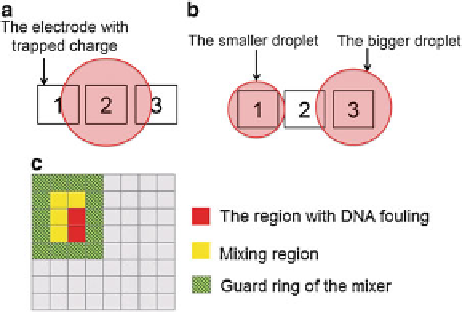Hardware Reference
In-Depth Information
Fig. 2.8
(
a
) An error caused by the phenomenon of charge trapping; (
b
) splitting operation with
droplets with unbalanced volumes; (
c
) an error caused by DNA fouling on the surface of a biochip
Suppose Electrode 1 has trapped charge in its dielectric insulator layer, while
Electrode 2 and 3 do not suffer from trapped charge. In order to implement a
splitting operation, actuation voltages are applied on Electrode 1 and Electrode 3.
However, the charge trapped on Electrode 1 will weaken the electrowetting force.
The droplet will be split by unequal forces, and the two resulting droplets may have
unequal volumes; see Fig.
2.8
b. If we simply re-execute the splitting operation and
continue to use Electrode 1, additional errors may result. Even worse, the charge-
trapping phenomenon may eventually cause permanent dielectric degradation of the
electrode [
7
,
8
]. Thus, in order to ensure the reliability of the biochip, the electrode
at which the error occurred must no longer be used to implement fluid-handling
operations once an error is detected.
The droplets containing macromolecules (such as DNA) may foul the surface
of the electrodes [
20
]. As a result, droplet concentration can change in undesirable
ways. If we continue to use these contaminated electrodes, other droplets may also
be contaminated. An example of this is shown in Fig.
2.8
c. The region where DNA
fouling occurred is used as part of a mixer, and the output droplets of the mixing
operation may have abnormal concentrations.
We use a simple strategy to ensure a reliability-driven error-recovery. When an
error is detected, we update the execution of the bioassay as follows:
•
The operation with error is re-executed.
•
The electrodes that may lead to errors will not be used in other operations.
Note that the on-chip resources occupied by each operation are recorded by the
control software. Thus depending on the error droplet, it is feasible to backtrace
to the region where error occurs. We consider all electrodes in this region as
the suspicious locations for defects. These electrodes will therefore be bypassed.

